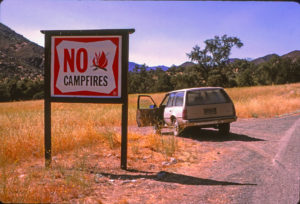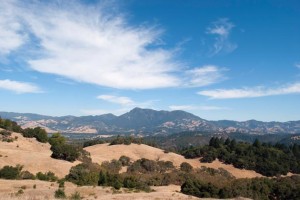Mary Ellen Hannibal wrote about the TBC3 Initiative and Pepperwood Preserve in the July issue of Bay Nature.
iodiversity scientists tend to love the outdoors. Ironically, most of their work occurs inside. At the first meeting of the Terrestrial Biodiversity Climate Change Collaborative (TBC3), a three-day workshop held at the Pepperwood Preserve in Sonoma County in July 2010, one of the attending scientists chose not to bunk with the others at nearby lodgings, but instead elected to sleep under the stars. Have sleeping bag, will travel to conferences. At one point during a long discussion about computer models, someone entered the conference room and announced there was a snake outside. Every single person in the room jumped out of their chairs and out the door – to look at the snake, which was kind of hilariously unmoved by the attention (soaking up the sun).
I felt akin to the snake. Pepperwood is so darn beautiful, and the warm sun, the oak trees with their outstretched craggy branches – I wanted to stay outside too. But we headed back indoors to discuss “veg models,” which, of course, are not perfect red peppers. When the conversation went too far over my head I utilized wi-fi and searched out some of my sticking points. “Marxan,” if you really want to know, is a software used to inform the design and management of nature reserves. “Raster” has nothing to do with marijuana or reggae: It’s part of a “dot matrix data structure.” “Vector”? Please.
At lunch one day one of the organizers of the workshop, Dr. David Ackerly of UC Berkeley, asked how I was doing. “Fine,” I said. “Why do you like statistics so much?” Ackerly’s kindly face became painfully concerned as he took a moment to translate his thoughts into a language I could understand. “Statistics,” he said, “let me know what story I can tell.” I have thought about this sentence frequently over the four years since he uttered it. (He suggested I read Statistics for Dummies. Thanks David; the truth is I’ve tried and it’s too hard for me.)
The beauty of science is that it really does search for truth. It is easy to follow the tracks and trails of one or several of nature’s patterns and yet be completely lost as to the whole picture. So statistics are numbers that tell you what, exactly, is where, and in what amount. Scientists use them because they know the human eye is blinkered by biases we so take for granted we can’t possibly see past them. Statistics are a tool in service of the earnest desire to depict a picture of nature that is more accurate than we are yet capable of otherwise defining.
These scientists break down every piece of nature and every natural interaction into a tiny point to which they assign a number. Then they look at a map of all those numbers, and try to discern patterns in them. As I listened to these people talk about what patterns they are seeing where, and as (I confess) my mind wandered, I looked out the window and thought about how painters similarly express truths of nature. Seurat, for example, is a raster-master, reducing his scenes to little points of color that can be seen discretely like grids. Nature is both flattened and amplified in his technique. Van Gogh can be said to bring vectors to life through color, adding magnitude and direction and creating motion on the flat surface of the canvas. Van Gogh made nature all about color while science takes all the color out (usually). But the resulting pictures are similar in depicting vertiginous, dynamic, seemingly infinitely continuous interactions the whole of which is not just a picture, but a process. Almost makes me want to take a math class. But I think I’ll step outside to the living art gallery instead.



